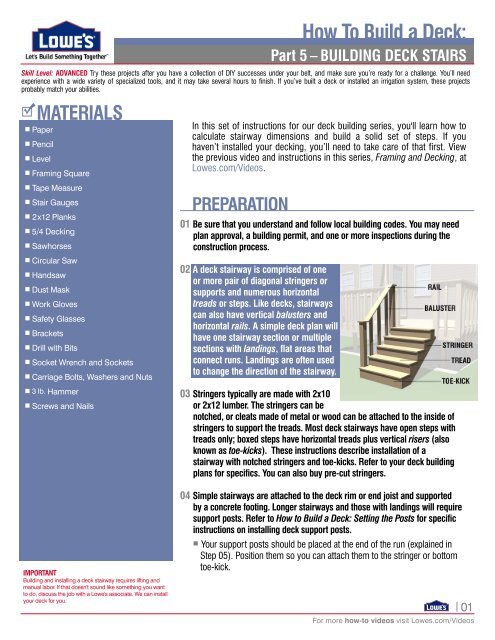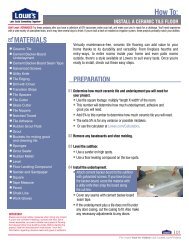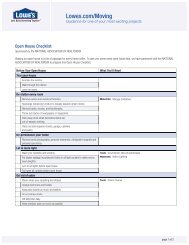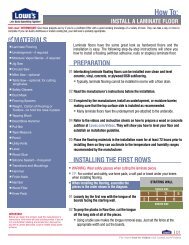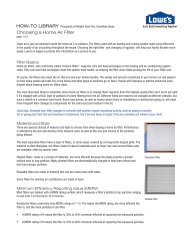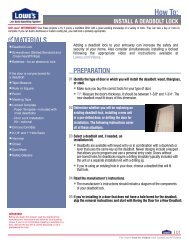Create successful ePaper yourself
Turn your PDF publications into a flip-book with our unique Google optimized e-Paper software.
<strong>How</strong> <strong>To</strong> <strong>Build</strong> a <strong>Deck</strong>:<br />
Part 5 – BUILDING DECK STAIRS<br />
Skill Level: ADVANCED Try these projects after you have a collection of DIY successes under your belt, and make sure you’re ready for a challenge. You’ll need<br />
experience with a wide variety of specialized tools, and it may take several hours to finish. If you’ve built a deck or installed an irrigation system, these projects<br />
probably match your abilities.<br />
MATERIALS<br />
Paper<br />
Pencil<br />
Level<br />
Framing Square<br />
Tape Measure<br />
Stair Gauges<br />
2x12 Planks<br />
5/4 <strong>Deck</strong>ing<br />
Sawhorses<br />
Circular Saw<br />
Handsaw<br />
Dust Mask<br />
Work Gloves<br />
Safety Glasses<br />
Brackets<br />
Drill with Bits<br />
Socket Wrench and Sockets<br />
Carriage Bolts, Washers and Nuts<br />
3 lb. Hammer<br />
Screws and Nails<br />
IMPORTANT<br />
<strong>Build</strong>ing and installing a deck stairway requires lifting and<br />
manual labor. If that doesn't sound like something you want<br />
to do, discuss the job with a <strong>Lowe's</strong> associate. We can install<br />
your deck for you.<br />
In this set of instructions for our deck building series, you'll learn how to<br />
calculate stairway dimensions and build a solid set of steps. If you<br />
haven’t installed your decking, you’ll need to take care of that first. View<br />
the previous video and instructions in this series, Framing and <strong>Deck</strong>ing, at<br />
Lowes.com/Videos.<br />
PREPARATION<br />
01 Be sure that you understand and follow local building codes. You may need<br />
plan approval, a building permit, and one or more inspections during the<br />
construction process.<br />
02 A deck stairway is comprised of one<br />
or more pair of diagonal stringers or<br />
supports and numerous horizontal<br />
treads or steps. Like decks, stairways<br />
can also have vertical balusters and<br />
horizontal rails. A simple deck plan will<br />
have one stairway section or multiple<br />
sections with landings, flat areas that<br />
connect runs. Landings are often used<br />
to change the direction of the stairway.<br />
03 Stringers typically are made with 2x10<br />
or 2x12 lumber. The stringers can be<br />
notched, or cleats made of metal or wood can be attached to the inside of<br />
stringers to support the treads. Most deck stairways have open steps with<br />
treads only; boxed steps have horizontal treads plus vertical risers (also<br />
known as toe-kicks). These instructions describe installation of a<br />
stairway with notched stringers and toe-kicks. Refer to your deck building<br />
plans for specifics. You can also buy pre-cut stringers.<br />
04 Simple stairways are attached to the deck rim or end joist and supported<br />
by a concrete footing. Longer stairways and those with landings will require<br />
support posts. Refer to <strong>How</strong> to <strong>Build</strong> a <strong>Deck</strong>: Setting the Posts for specific<br />
instructions on installing deck support posts.<br />
Your support posts should be placed at the end of the run (explained in<br />
Step 05). Position them so you can attach them to the stringer or bottom<br />
toe-kick.<br />
01<br />
For more how-to videos visit Lowes.com/Videos
PREPARATION (cont.)<br />
<strong>How</strong> <strong>To</strong> <strong>Build</strong> a <strong>Deck</strong>:<br />
Part 5 – BUILDING DECK STAIRS<br />
05 Use paper, pencil, level, framing square and tape measure to calculate a stairway<br />
run, the horizontal depth of the steps. Most building codes call for a minimum<br />
run of 9", but 11-12" may work better. The rise or vertical distance between<br />
the tread is typically about 7".<br />
TIP: A shorter rise is usually more comfortable with a deeper run, and a taller<br />
rise works better with a shorter run. A good rule to follow is the sum of the<br />
rise plus the run should equal about 17-½".<br />
1. Calculate the total rise of the stairway directly over the landing. Extend a level or straight 2x4 from<br />
the deck surface and take the measurement to the ground below. In our video, the total rise is 34".<br />
2. Divide this measurement by 7", the ideal height for each step. Round this number<br />
to the nearest whole number to get the number of risers. In our video,<br />
the number of risers is 5.<br />
3. Divide the total rise by the number of risers. For our example, we divide 34" by 5 to<br />
get the actual height of those risers, in this case, 6- 7 /8". If the result is too short for<br />
your preference, reduce the number of risers by 1 and calculate again.<br />
4. Calculate the run. The example uses two 5/4x6 decking planks for the tread, with<br />
drainage gaps about 1 /8". We added toe-kicks on the back of each step for a cleaner<br />
look. In the example, the unit run will be 11". Refer to your deck building plans for<br />
details on the run.<br />
06 Calculate the length of the stringers.<br />
1. Refer to a framing square.<br />
One side is marked in 12ths, allowing you to scale 1' down to 1". For instance, 8'<br />
on a framing square is marked at the 8" line. The smaller lines are inch marks that<br />
make up one foot.<br />
2. Calculate the total run (number of treads x individual run = total run).<br />
The example total run is 5 treads x 11" = 55" or 4' 7". Hold the end of a tape<br />
measure along the left side of the square at 4' 7" or your calculated total run mark.<br />
3. Locate the total rise (determined in 05-1 above).<br />
In the example, it is 34" (see above) or 2' 10". While still holding the end of the<br />
tape measure on the left side, move the tape to the 2' 10" mark on the right side<br />
of the framing square.<br />
4. With the tape measure on these two marks, take note of the measurement and<br />
hold it along the framing square. It will show you the minimum length for the<br />
stringers. In the example: 5' 3", so you will cut the stringers from two 6' planks.<br />
02<br />
For more how-to videos visit Lowes.com/Videos
MAKING THE STRINGERS<br />
01 Set stair gauges on the framing square at the height of the rise and length of the run.<br />
02 Hold the square at the corner of the plank, and mark the top step.<br />
03 Slide the square along the plank and mark the next step.<br />
04 Continue marking until you have your number of steps.<br />
05 At the top step, hold the square under the mark and make a perpendicular line.<br />
This is where the stairway will attach to the deck.<br />
06 At the bottom step, hold a piece of tread where the stairway will rest on<br />
the ground. Mark this line, which will shift the stairway down by the<br />
thickness of the tread. Now when you attach the top tread to the stairway,<br />
it should be flush with the decking.<br />
07 Cut the first stringer with a circular saw, finishing the cuts with a handsaw.<br />
SAFETY TIP: Always wear a dust mask and safety glasses when cutting treated lumber.<br />
Apply a weather sealer to the cut ends of treated lumber.<br />
<strong>How</strong> <strong>To</strong> <strong>Build</strong> a <strong>Deck</strong>:<br />
Part 5 – BUILDING DECK STAIRS<br />
03<br />
For more how-to videos visit Lowes.com/Videos
MAKING THE STRINGERS (cont.)<br />
08 Use the cut stringer as a template to mark subsequent stringers.<br />
09 Cut the next stringer.<br />
Complex stairways may require multiple stairway runs with landings. Refer to<br />
your deck construction plan for specific dimensions and requirements.<br />
ASSEMBLING THE STAIRWAY<br />
<strong>How</strong> <strong>To</strong> <strong>Build</strong> a <strong>Deck</strong>:<br />
Part 5 – BUILDING DECK STAIRS<br />
01 Refer to your construction plans and local building codes to make sure that stairway construction will comply.<br />
02 Mark on the deck joist where the stairway will attach.<br />
The video example stairway is 48" wide, supported at the deck with brackets and<br />
at the bottom step with posts.<br />
03 Secure the stringers to the deck flush with the top of the joist.<br />
If using brackets, conceal them by attaching them to the inside of the steps.<br />
04 Cut all of the treads and, if used, toe-kicks.<br />
The tread width will depend on whether they are installed on top or inside of the<br />
stringers. Refer to the deck construction plan.<br />
05 If used, install all toe-kicks with screws.<br />
06 If attaching the steps to posts, use carriage bolts to secure them to the posts.<br />
07 Install the treads.<br />
If using two boards for the tread, use a nail as a spacer between the treads to allow for drainage.<br />
The deck stairway is in place and there are only a few more things needed to finish your deck. Next, you'll install<br />
the railings and skirting. Check out Finishing the <strong>Deck</strong>, at Lowes.com/Videos.<br />
These "<strong>How</strong>-<strong>To</strong>'s" are provided for informational purposes only. The information contained in <strong>Lowe's</strong> "<strong>How</strong>-<strong>To</strong>" videos is intended to provide<br />
general guidance to simplify jobs around the house. Because tools, products, materials, techniques, building codes and local regulations<br />
are continually changing, <strong>Lowe's</strong> assumes no responsibility for the accuracy of the information contained herein and disclaims any liability<br />
for omissions, errors or the outcome of any project. It is the responsibility of the viewer to ensure compliance with all applicable laws,<br />
rules, codes and regulations for a project. The viewer must always take proper safety precautions and exercise caution when taking on<br />
any project. If there is any question or doubt in regards to any element of a project, please consult with a licensed professional.<br />
04<br />
For more how-to videos visit Lowes.com/Videos


